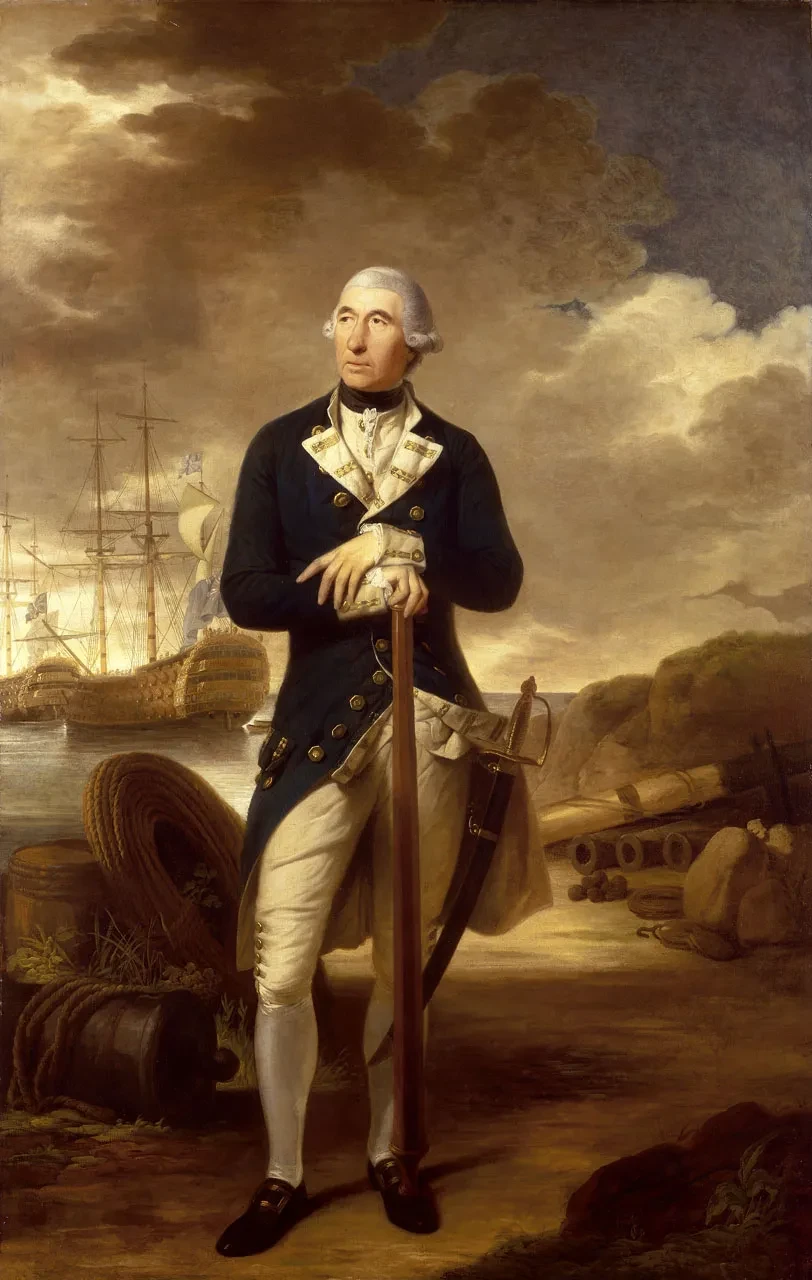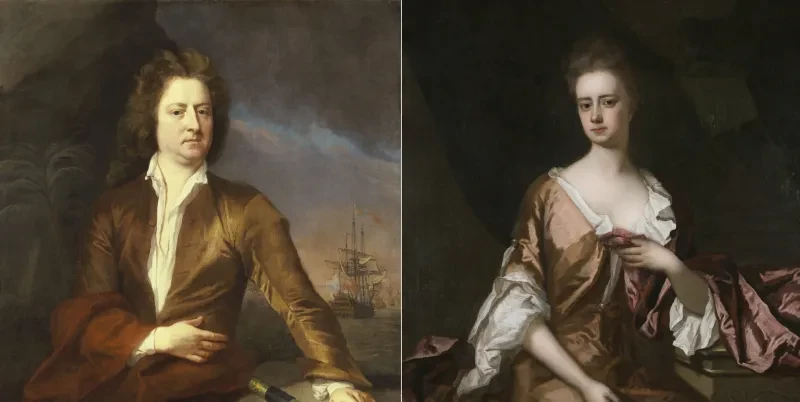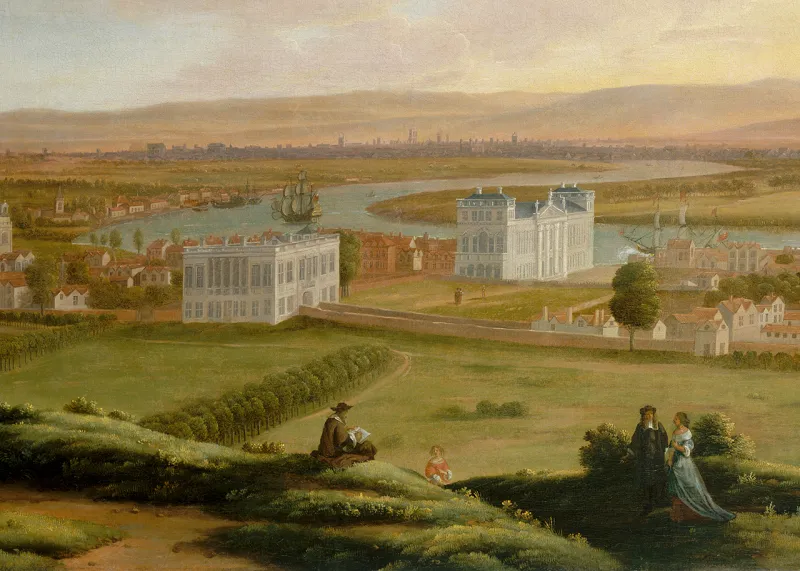
In the confines of a ship’s cabin, an in-depth meeting takes place between two naval officers and a clerk.
Depicting Vice-Admiral Sir Samuel Cornish, Captain Richard Kempenfelt and Thomas Parry, this triple portrait was the most ambitious work of its artist, Tilly Kettle.

Characterised by its striking contrasts and exquisitely rendered details, it offers a unique insight into the relationship between British art and colonialism.
Now on public display for the first time in more than 250 years, the painting was acquired by Royal Museums Greenwich in 2021, with support from Art Fund and the Society for Nautical Research Macpherson Collection Endowment Fund.
Take a closer look at this arresting artwork.
Shipboard conversations
Measuring around two metres in height and length, this sizeable painting provides a glimpse into administrative life at sea.
To the right sits Vice-Admiral Sir Samuel Cornish. He is issuing orders to flag captain Richard Kempenfelt, who stands at the left-hand side.
However, it is the figure at the centre of the painting who really catches the eye.
“While Cornish and Kempenfelt look at one another, seemingly absorbed in conversation, the admiral’s secretary arrests the viewer’s attention with his confident gaze,” says Katherine Gazzard, Curator of Art at Royal Museums Greenwich.
This is Thomas Parry, his quill poised over a stack of papers. Wearing light-coloured clothes in contrast to the dark uniforms of his colleagues, Parry’s prominent position references his status as the work’s patron.
“While many captains and admirals commissioned grand portraits in this period, lower-ranking warrant officers like Parry could seldom afford to do so,” Gazzard explains.
Art, ambition and colonialism
In 1768, Parry commissioned Tilly Kettle to bring his artistic vision to life. As Gazzard explains, this work is a statement of Parry’s upwards social mobility: “It is remarkable that an admiral’s secretary had both the aspirational desire and the financial resources to commission such a powerful status symbol.”
The son of a London wigmaker, Parry came from humble origins, but he amassed great wealth and status over the course of his life. His naval career led to a lucrative post as a Director of the East India Company.
However, Gazzard notes, the intensity of Parry’s gaze belies a more unsettling story. “In Parry’s confident gaze, the portrait brings us face-to-face with an individual whose desire for social and financial gain helped to fuel British colonial expansion and the abuses committed in the course of this process.”
Discover more great art
Sign up to the art newsletter for more information about Royal Museums Greenwich's art collection, and learn about upcoming exhibitions and events.
Behind the scenes of the Royal Navy
Set on board the Norfolk, the painting provides a unique depiction of the interior of an 18th century British warship. The painting commemorates the trio’s involvement in the capture of Manila – a Spanish trading base – in 1762.
For Gazzard, the setting of the ship’s cabin – a rare subgenre of maritime portraiture – offers an intriguing perspective into the workings of the Navy.
Unlike other naval portraits from this period, which typically show sitters on deck or in coastal settings accompanied by scenes of naval battles and storms, Gazzard explains that this painting is a celebration of naval bureaucracy.
“Parry’s central position in the composition stresses the importance of bureaucracy and administration within the sea service,” she says.
Life at sea
Royal Museums Greenwich is home to a world-leading collection of 18th century naval portraits. Discover other related works in our collection.
Who was Tilly Kettle?
An important figure in the history of 18th century British art, Kettle worked at the same time as artists including Thomas Gainsborough and Joshua Reynolds. Parry’s commission marked a turning point in Kettle’s career.
“The commission for the triple portrait provided the artist with a valuable opportunity to showcase his abilities,” Gazzard says. “As a large-scale group portrait, something Kettle had never previously attempted, it was his most ambitious work to date.”
However, London’s art scene was notoriously cutthroat. After completing Parry’s commission, Kettle’s triple portrait made little impact on the capital’s artistic establishment.
“Kettle failed to secure significant patronage in London, and he was overlooked for membership of the newly founded Royal Academy,” Gazzard says.
Instead, Kettle followed in the footsteps of many of his fellow artists and sought opportunities in Britain’s colonies. “With his career stagnating in London, he relocated his business to India, where he became the first British artist to run a profitable practice,” Gazzard says. “Between 1769 and 1776, he made a small fortune painting colonial officials and Indian princes.”
An important legacy
Drawing on themes of migration, trade and the role of the Navy, this painting shines a light on life at sea during a crucial moment in Britain’s colonial history.
While forming a key addition to Royal Museums Greenwich’s collection of 18th century naval portraits, Kettle’s painting – and the story of its creation – highlights the uncertain life of an artist during this era.
“Encompassing both success and failure, Kettle’s story has much to tell us about the 18th century British art world and especially about the opportunities and risks that British imperial expansion created for artists,” Gazzard says.
“The triple portrait affords an opportunity to explore portraiture as a record of the social, economic and cultural aspirations of individuals within the broader context of British colonial and imperial expansion.”








